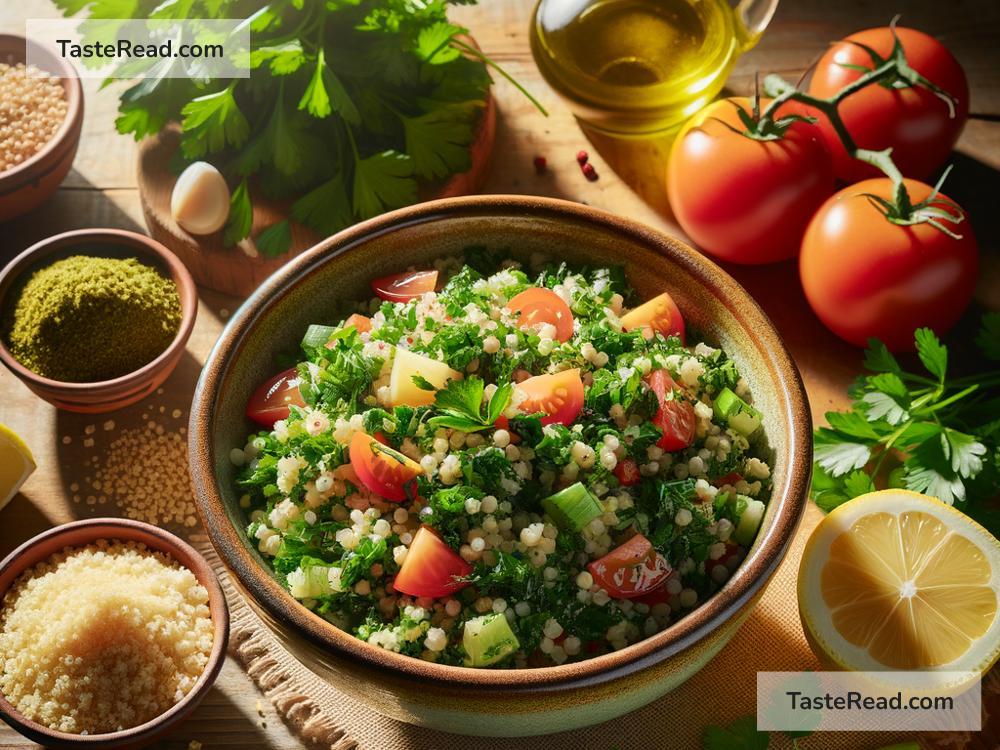Tabbouleh: A Taste of Lebanon Passed Through Generations
Food has a magical way of connecting people. It brings families together, tells stories, and teaches traditions. In Lebanon, one dish has stood the test of time, bringing vibrant flavors and heartfelt memories to every table: tabbouleh. A refreshing, colorful salad made with parsley, bulgur wheat, tomatoes, and more, tabbouleh is more than just food; it’s a celebration of Lebanese heritage. In this blog, we’ll explore the history of tabbouleh and share how families pass their treasured recipes through generations.
What is Tabbouleh?
Tabbouleh (pronounced ta-boo-lee) is a classic dish in Lebanese cuisine and is considered one of the country’s national treasures. It’s a light, healthy salad that’s perfect for almost any meal. The main star of the dish is finely chopped parsley, accompanied by bulgur wheat, ripe tomatoes, fresh mint, olive oil, and a splash of lemon juice for zest. Some recipes may include green onions, cucumber, or garlic for extra flavor.
The name “tabbouleh” comes from the Arabic word taabil, meaning “seasoning.” And that’s exactly what the dish represents—perfectly balanced flavors that awaken your taste buds.
A Dish with Deep Roots
Tabbouleh has been a part of Lebanese kitchens for centuries. Historians believe it originated in the mountains of Lebanon and Syria hundreds of years ago. Back then, parsley and mint grew easily in the Mediterranean region, making them abundant and affordable ingredients. Families learned how to turn these everyday herbs into something extraordinary by combining them with bulgur wheat, tomatoes, and a simple dressing.
In Lebanon, tabbouleh isn’t just food; it’s a symbol of culture, hospitality, and pride. The dish is often enjoyed during large family gatherings, weddings, and celebrations. It’s served as part of the traditional Lebanese mezze—an assortment of small dishes meant to be shared around the table.
Recipes Passed Through Generations
What makes tabbouleh so special is how every family has their own version of the recipe. While the basic ingredients remain the same, the proportions and preparation techniques can differ greatly depending on family traditions. For example, one grandmother might prefer her tabbouleh with extra parsley and only a hint of bulgur wheat, while another might add more tomatoes for sweetness. Some families use onion for added crunch, while others stick strictly to mint as a complement.
Ask any Lebanese cook, and they’ll likely tell you that their tabbouleh recipe is “the best” and has been in their family for generations. Here’s the beauty of food like tabbouleh—each family’s recipe becomes a treasured heirloom. It’s not just about the ingredients; it’s about the love and care passed down from grandmother to grandson, father to daughter.
Learning Tabbouleh from Grandma’s Kitchen
In many Lebanese homes, tabbouleh is the kind of dish you learn to make as a child. Imagine sitting beside your grandmother, watching her skillfully chop the parsley into tiny pieces with a sharp knife or squeeze fresh lemons to make the vibrant dressing. These moments become cherished memories, teaching not only cooking skills but also respect for tradition.
One Lebanese grandmother, Miriam, shared how she taught her granddaughter to make tabbouleh: “When I was a little girl, my mother showed me how to chop parsley the right way—never too big or messy. Now, I make tabbouleh with my granddaughter. She gets the ingredients ready, and I show her how to mix them with love.”
Miriam’s secret for perfect tabbouleh? Always use patience. “You can’t rush good food,” she says. She also insists on using the freshest ingredients—the parsley must be bright green, the lemons juicy, and the olive oil rich and smooth.
A Simple Tabbouleh Recipe
If you’d like to try making tabbouleh at home, here’s a simple and traditional recipe:
Ingredients:
- 1 cup fresh parsley (finely chopped)
- ¼ cup fresh mint (finely chopped)
- 1 medium tomato (diced)
- 2 tablespoons bulgur wheat (soaked in water for 10 minutes, then drained)
- 1 tablespoon green onion (optional, finely chopped)
- 2 tablespoons fresh lemon juice
- 2 tablespoons olive oil
- Salt to taste
Instructions:
- Start by soaking the bulgur wheat in water for 10 minutes, then drain and set aside.
- Wash and dry the parsley, mint, and green onion (if using). Chop them finely.
- Dice the tomato into small cubes.
- In a large bowl, combine the chopped parsley, mint, tomato, and green onion.
- Add the soaked bulgur wheat to the bowl.
- Drizzle the olive oil and lemon juice over the salad. Sprinkle with salt to taste.
- Mix everything gently but thoroughly.
- Serve immediately or chill for a few minutes for the flavors to blend. Enjoy!
Preserving Tradition One Salad at a Time
Tabbouleh is more than a dish; it’s a symbol of Lebanese identity and love. By teaching their children and grandchildren how to make tabbouleh, Lebanese families ensure their culinary traditions stay alive for years to come. Whether you’re eating tabbouleh in a cozy Lebanese home or making it in your own kitchen, each bite carries the essence of generations past.
Try this recipe and share the joy of tabbouleh with your family and friends. Who knows? It might become a tradition in your home, too!


